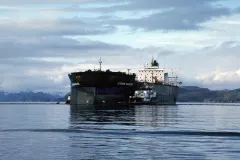Five Questions for Richard Carson, Natural Resource Economist

 In 1989, the Exxon Valdez oil tanker ran aground in Alaska’s Prince William Sound, spilling 11 million gallons of crude oil into the water and onto the beaches of the remote ecosystem. Richard Carson is an economics professor at the University of California, San Diego who led the team that assessed the costs of the spill to the environment in the form of dead fish, mammals and services the ecosystem provided that were lost.
In 1989, the Exxon Valdez oil tanker ran aground in Alaska’s Prince William Sound, spilling 11 million gallons of crude oil into the water and onto the beaches of the remote ecosystem. Richard Carson is an economics professor at the University of California, San Diego who led the team that assessed the costs of the spill to the environment in the form of dead fish, mammals and services the ecosystem provided that were lost.
The Ocean Portal team asked Richard five questions to learn more about how to place a value on environmental resources that don’t come with an obvious price tag and how this connects to the Exxon Valdez oil spill:
What do you do?
I am an economics professor at the University of California, San Diego and work in the field of environmental and natural resource economics. One project I’m working on examines what it is worth to save a large tract of tropical rainforest in Malaysia that, if preserved, could be protected from logging and, even more challenging, from poaching. Another project for the State of California tries to predict who will purchase all electric and plug-in hybrid cars as their availability and cost change. And still other projects are on how to improve fisheries management decisions and forecasting future Chinese emissions of carbon dioxide.
How does that relate to the Exxon-Valdez oil spill?
As an environmental economist, I try to figure out the monetary values that people place on environmental amenities (like clean air and beautiful scenery) and ecosystem services (like water-purifying salt marshes and natural medicines) that are not bought and sold in the marketplace. These are referred to as non-marketed goods because they don’t come with an obvious price tag, like a car or a coat would have. I served as the lead scientist for the government for the study that placed a value on the injuries done to non-marketed goods (such as sea otters and Gulf of Alaska beaches) by the Exxon Valdez oil spill.
How do you measure the cost of a natural disaster like the Exxon Valdez oil spill?
Different types of costs are measured in different ways. Some of the costs are relatively easy, like the money spent on cleaning up the spill. For some other types of losses, what an economist does is estimate lost profits. For instance, we estimated how much money the fishing industry lost by calculating how much fish would have been caught without the oil spill, determining how much money they would have sold for, and then subtracting what the cost of catching the fish would have been.
But many losses in natural disasters are harder to measure in dollars and cents. Instead, we measure monetary value by the tradeoffs that people are willing to make. For example, economists typically look at how much farther people are willing to travel (which costs time and money) for better quality fishing and use that information to infer the monetary value placed on fishing quality. In some cases, even these direct tradeoffs are hard to measure. What is the value of protecting a large distant ecosystem like Prince William Sound where the Exxon Valdez spill took place? Economists, often with the help of surveys, look at what people are willing to pay in the form of higher taxes or higher prices on goods like gasoline to get better protection for the area.
Are we still paying for this oil spill, 24 years later?
Yes, in the sense that some of the harm done to fish and wildlife in Alaska lasted much longer than was first thought would be the case. As an economist, though, what I naturally think about is the fact that we have been spending more money since the Exxon Valdez spill in the ongoing effort to prevent another similar occurrence. While the public rarely hears about it, the protection plan put into place after the Exxon Valdez oil spill has successfully prevented several major spills in Prince William Sound. And each time that happens, we are in a sense still paying for the spill. In one case a few years after the spill, a supertanker lost power in the Straits of Valdez and was drifting toward a reef near the one hit by the Exxon Valdez. One of the escort tugs, provided by the new protection plan, pushed the supertanker away from the reef while the other escort tug shot it a tow line and pulled it far away from the reefs so that its engines could be safely repaired. When things like this happen you feel good about the work you do.
What was the most surprising thing you learned about the Exxon Valdez spill?
I was surprised at how little natural scientists knew about Prince William Sound. It was a remote, largely pristine wilderness area and the lack of good baseline data made it hard to determine exactly the extent of the harm that had been done by the spill.
More from this series:

